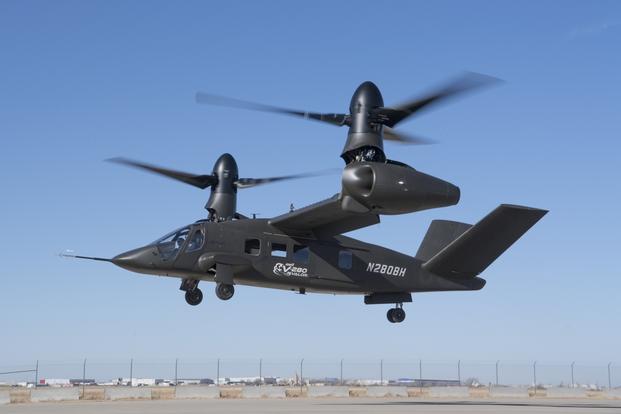Next week, a team from Textron Inc. and Bell Helicopter will demonstrate the maneuverability of its experimental V-280 Valor helicopter, a platform that may one day replace the U.S. military's UH-60 Black Hawk fleet.
The June 18 demonstration comes six months after the V-280's first test flight as a technology demonstrator in the Army's Future Vertical Lift program.
"It's not just a flight test, it's actually a demonstration of what we have been able to achieve so far," retired Army Maj. Gen. Jeff Schloesser, executive vice president for strategic pursuits at Bell, told Military.com.
"What you will see is the aircraft go through a variety of maneuvers. ... One of the things we want to demonstrate is just how able you are to quickly reposition the aircraft in flight," he said. "When you are on the objective area, you are not flying fast, but what you do have to do is do tail maneuvers, turn maneuvers, roll and pitch maneuvers in a very accelerated way."
The V-280 is one of two multi-role technology demonstrator platforms the service selected in 2014 to prove out new capabilities for Future Vertical Lift, an Army-led, joint program to create futuristic helicopters designed to far exceed the performance of legacy aircraft such as the Army Black Hawk and Marine Corps H-1.
Sikorsky, part of Lockheed Martin Corp., and Boeing Co. built the SB>1 Defiant as the other technology demonstrator, but so far the Defiant has not conducted its first test flight.
Bell and its partners have invested several hundred million dollars in the Valor in the hope that a form of it will one day meet the requirements for the long-range assault helicopter variant of FVL.
"That is what our V-280 is aimed at, the one that carries 12 to 14 passengers, the size of an augmented Army squad or a U.S. Marine Corps squad," Schlosser said.
Through the end of this year, Bell will attempt to prove it can meet performance goals for the Valor such as speed and extended range.
The aircraft can currently fly at 195 knots, but it will soon be able to reach a max speed of 280 knots, Schlosser said.
"The V-280 is named after the goal to fly at 280 knots, which is more than twice the speed of a Black Hawk," he said. "Over the next few months, you will see us aim for that high-end speed above 195 ... up to 280."
The V-280 will also be able to fly at least 400 nautical miles without refueling, Schlosser said.
"It all depends on the mission, but [what] we are really talking about is being able to do a 200-nautical-mile air assault and come on back," he said.
At the end of the year, the goal is to fly the aircraft in an "autonomous manner," Schlosser said, explaining that the military is very interested in "supervised autonomy that frees up aviators up in front to concentrate on accomplishing the overall combat mission rather than just flying the airframe from one spot to another spot."
It is unclear when the Army will make a decision on its two tech demonstrators, but Schlosser said there is still work to be done in the effort.
"The idea that you have to make a choice right now and it's either one or the other, I don't think is accurate," he said.
At the same time, Bell and its partners have invested $500 million into the Valor.
"We made a huge investment in this already," he said. "We can go as fast as the Army ... would like to go. We are here to support them; we are not here to tell them how to run their business. But we are reminding them that we cannot just keep engineers out there doing something without contracts and things of that nature."
Schlosser is confident that Army leaders will not make the same mistakes as they did in the failed Future Combat Systems Program, an effort that resulted in many expensive, high-tech platforms, such as the futuristic Comanche attack helicopter, being canceled.
"I helped cancel some of them. Remember I was twice director of Army aviation," he said. "There is no doubt that we have got that in the back of our minds."
But Schlosser also said he believes that the sophisticated military technology being fielded by potential adversaries such as Russia and China is real.
"I think that ... there is a realization our vaunted military in some cases is less relevant than it used to be, say, five to 10 years ago," he said.
"So now you've got this very sophisticated problem" that's going to require that our military "operate in a very intense and chaotic battlefield and survive it though speed, and range and survivability," Schlosser said.
-- Matthew Cox can be reached at matthew.cox@military.com.










